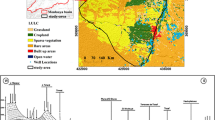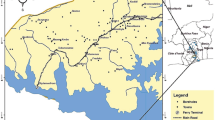Abstract
Karst systems are particularly vulnerable to overexploitation and pollution due to their high hydraulic conductivity and points of rapid infiltration that allow quick influx of runoff and pollutants into the aquifer. The sustainability of non-contaminated groundwater in these systems is imperative for both humans and groundwater-dependent ecosystems. An important practice in managing groundwater sustainability involves assessing aquifer vulnerability. This study created the first groundwater vulnerability map (GVM) for a sub-catchment of the Rio La Venta watershed in Chiapas, Mexico, using an adaptation of the hazard–pathway–target method. This project also conducted the first tracer study in the Rio la Venta watershed to establish connectivity between the catchment and the Rio La Venta Canyon. Finally, this study evaluated the results of the GVM through a sensitivity analysis. Results of the GVM clearly demarcate areas of very high, high, moderate, and low vulnerability within the study area most of which being classified as low vulnerability. The zones of high vulnerability were successfully validated through two dye tracer tests that measured rapid groundwater flow velocities. With the limited resources available to land managers in this area, a problem common in many developing countries, tools that quickly and inexpensively highlight areas that require special protection to help maintain or improve water quality in their watersheds have great utility. Conveying this information to land managers and policymakers can lead to potential changes in current land use practices and allow for the reallocation of resources in support of reducing future negative human–landscape interactions.






Similar content being viewed by others
References
Aley T, Fletcher MW (1976) The water tracer’s cookbook. Mo Speleol 16(3):1–32
Andreo B, Goldscheider N, Vadillo I, Vías JM, Neukum C, Sinreich M, Jiménez P, Brechenmacher J, Carrasco F, Hötzl H, Perles MJ (2006) Karst groundwater protection: first application of a Pan-European approach to vulnerability, hazard and risk mapping in the Sierra de Líbar (Southern Spain). Sci Total Environ 357(1):54–73
Bernabei T, De Vivo A, Sauro F, Savino G (eds) (2012) Cueva del Río La Venta: an underground dream. La Venta Esplorazione Geografiche, Italy, p 159
Bonacci O, Pipan T, Culver DC (2009) A framework for karst ecohydrology. Environ Geol 56(5):891–900
Connair DP, Murray BS (2002) Karst groundwater basin delineation, Fort Knox, Kentucky. Eng Geol 65(2):125–131
Cros P, Michaud F, Fourcade E, Fleury JJ (1998) Sedimentological evolution of the Cretaceous carbonate platform of Chiapas (Mexico). J South Am Earth Sci 11(4):311–332
Culver DC, Holsinger JR (1992) How many species of troglobites are there. Natl Speleol Soc Bull 54:79–80
Daly D, Dassargues A, Drew D, Dunne S, Goldscheider N, Neale S, Popescu I, Zwahlen F (2002) Main concepts of the “European approach” to karst-groundwater-vulnerability assessment and mapping. Hydrogeol J 10(2):340–345
Deharveng L, Stoch F, Gibert J, Bedos A, Galassi D, Zagmajster M, Brancelj A, Camacho A, Fiers F, Martin P, Giani N (2009) Groundwater biodiversity in Europe. Freshw Biol 54(4):709–726
Doerfliger N, Jeannin PY, Zwahlen F (1999) Water vulnerability assessment in karst environments: a new method of defining protection areas using a multi-attribute approach and GIS tools (EPIK method). Environ Geol 39(2):165–176
Ford D, Williams PW (2013) Karst hydrogeology and geomorphology. Wiley, New York
Gogu RC, Dassargues A (2000) Current trends and future challenges in groundwater vulnerability assessment using overlay and index methods. Environ Geol 39(6):549–559
Goldscheider N (2005) Karst groundwater vulnerability mapping: application of a new method in the Swabian Alb, Germany. Hydrogeol J 13(4):555–564
Goldscheider N, Hötzl H, Fries W, Jordan P (2001) Validation of a vulnerability map (EPIK) with tracer tests (2001). In: Mudry J, Zwahlen F (eds) 7th conference on limestone hydrology and fissured media, Besançon, France, University de Franche-Comté, Besançon, pp 167–170, 20–22 Sept 2001
Guastaldi E, Graziano L, Liali G, Brogna FN, Barbagli A (2014) Intrinsic vulnerability assessment of Saturnia thermal aquifer by means of three parametric methods: SINTACS, GODS and COP. Environ Earth Sci 72(8):2861–2878
Hsu CC, Sandford BA (2007) The Delphi technique: making sense of consensus. Pract Assess Res Eval 12(10):1–8
Jiménez-Madrid A, Carrasco F, Martínez C, Gogu RC (2013) DRISTPI, a new groundwater vulnerability mapping method for use in karstic and non-karstic aquifers. Q J Eng Geol Hydrogeol 46(2):245–255
Kattaa B, Al-Fares W, Al Charideh AR (2010) Groundwater vulnerability assessment for the Banyas catchment of the Syrian coastal area using GIS and the RISKE method. J Environ Manag 91(5):1103–1110
Kavouri K, Plagnes V, Tremoulet J, Dörfliger N, Rejiba F, Marchet P (2011) PaPRIKa: a method for estimating karst resource and source vulnerability—application to the Ouysse karst system (southwest France). Hydrogeol J 19(2):339–353
Krasilnikov P, del Carmen Gutiérrez-Castorena M, Ahrens RJ, Cruz-Gaistardo CO, Sedov S, Solleiro-Rebolledo E (2013) The soils of Mexico. Springer, Berlin
Lilburne L, Tarantola S (2009) Sensitivity analysis of spatial models. Int J Geogr Inf Sci 23(2):151–168
Marín AI, Dörfliger N, Andreo B (2012) Comparative application of two methods (COP and PaPRIKa) for groundwater vulnerability mapping in Mediterranean karst aquifers (France and Spain). Environ Earth Sci 65(8):2407–2421
Moss P (2013) Recharge area delineations and hazard and vulnerability mapping in Perry County, Missouri. Carbonates Evaporites 28(1–2):175–182
Mull DS, Liebermann TD, Smoot JL, Woosley LH (1988) Application of dye-tracing techniques for determining solute-transport characteristics of ground water in karst terranes. Environmental Protection Agency, Atlanta, GA (United States). Region IV, 1 Oct 1988
Napolitano P, Fabbri AG (1996) Single-parameter sensitivity analysis for aquifer vulnerability assessment using DRASTIC and SINTACS. IAHS Pub Ser Proc Rep Int Assoc Hydrol Sci 235:559–566
National Water Commission of Mexico (2010) Statistics on water in Mexico (2010 edition)
Neukum C, Hötzl H, Himmelsbach T (2008) Validation of vulnerability mapping methods by field investigations and numerical modelling. Hydrogeol J 16(4):641–658
Perrin J, Pochon A, Jeannin PY, Zwahlen F (2004) Vulnerability assessment in karstic areas: validation by field experiments. Environ Geol 46(2):237–245
Plan L, Decker K, Faber R, Wagreich M, Grasemann B (2009) Karst morphology and groundwater vulnerability of high alpine karst plateaus. Environ Geol 58(2):285–297
Prussian K, Baichtal J (2004) Delineation of a karst watershed on Prince of Wales Island, Southeast Alaska. In: Furniss M, Clifton C, Ronnenberg R (eds) Advancing the fundamental sciences: Proc. For. Ser. Natl. Earth Sci Conf., pp 111–117
Quinlan JF (1989) Ground-water monitoring in karst terranes: recommended protocols and implicit assumptions. US Environmental Protection Agency, Environmental Monitoring Systems Laboratory
Ravbar N, Goldscheider N (2007) Proposed methodology of vulnerability and contamination risk mapping for the protection of karst aquifers in Slovenia. Acta Carsolog 36(3):397–411
Ravbar N, Goldscheider N (2009) Comparative application of four methods of groundwater vulnerability mapping in a Slovene karst catchment. Hydrogeol J 17(3):725–733
Ravbar N, Kranjc A (2007) The protection of karst waters: a comprehensive Slovene approach to vulnerability and contamination risk mapping. Inštitut za raziskovanje krasa ZRC SAZU
Saidi S, Bouri S, Ben Dhia H (2011) Sensitivity analysis in groundwater vulnerability assessment based on GIS in the Mahdia-Ksour Essaf aquifer, Tunisia: a validation study. Hydrol Sci J 56(2):288–304
UN General Assembly (2010). Resolution: the human right to water and sanitation, 2010 (A/RES/64/292)
van Beynen PE, Niedzielski MA, Bialkowska-Jelinska E, Alsharif K, Matusick J (2012) Comparative study of specific groundwater vulnerability of a karst aquifer in central Florida. Appl Geogr 32(2):868–877
Vega FJ, García-Barrera P, Perrilliat MD, Coutiño MA, Marino-Pérez R (2006) El Espinal, a new plattenkalk facies locality from the Lower Cretaceous Sierra Madre Formation, Chiapas, southeastern Mexico. Revista mexicana de ciencias geológicas 23(3):323–333
Vías JM, Andreo B, Perles MJ, Carrasco F, Vadillo I, Jiménez P (2006) Proposed method for groundwater vulnerability mapping in carbonate (karstic) aquifers: the COP method. Hydrogeol J 14(6):912–925
Vías J, Andreo B, Ravbar N, Hötzl H (2010) Mapping the vulnerability of groundwater to the contamination of four carbonate aquifers in Europe. J Environ Manag 91(7):1500–1510
Vrba J, Zaporozec A (1994) Guidebook on mapping groundwater vulnerability. In: International contributions to hydrogeology, vol 16. H. Heise, Hannover, p 131
Yıldırım M, Topkaya B (2007) Groundwater protection: a comparative study of four vulnerability mapping methods. CLEAN Soil Air Water 35(6):594–600
Zhang Q (2015) An assessment of groundwater resource vulnerability to pollution in the Jiangjia spring basin, China. Environ Earth Sci 74(2):985–995
Zwahlen F (2004) Vulnerability and risk mapping for the protection of carbonate (karst) aquifers, final report (COST action 620). European Commission, Directorate-General XII Science. Research and Development, Brussels, p 297
Acknowledgements
Support for this project was provided by the University of South Florida, U.S. Forest Service International Programs, and the Biosfera de la Reserva Selva el Ocote. Thanks to Manuel Hernandez, Tory Houser, and Ben Tobin for their assistance with the dye trace.
Author information
Authors and Affiliations
Corresponding author
Rights and permissions
About this article
Cite this article
Kovarik, J.L., van Beynen, P.E. & Niedzielski, M.A. Groundwater vulnerability mapping for a sub-catchment of the Rio La Venta watershed, Chiapas, Mexico. Environ Earth Sci 76, 797 (2017). https://doi.org/10.1007/s12665-017-7113-8
Received:
Accepted:
Published:
DOI: https://doi.org/10.1007/s12665-017-7113-8




